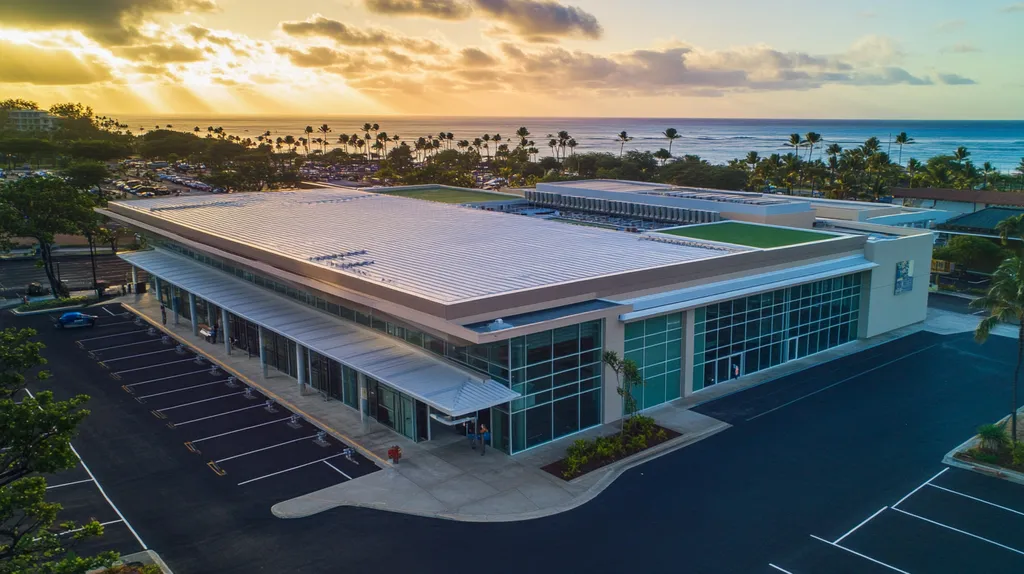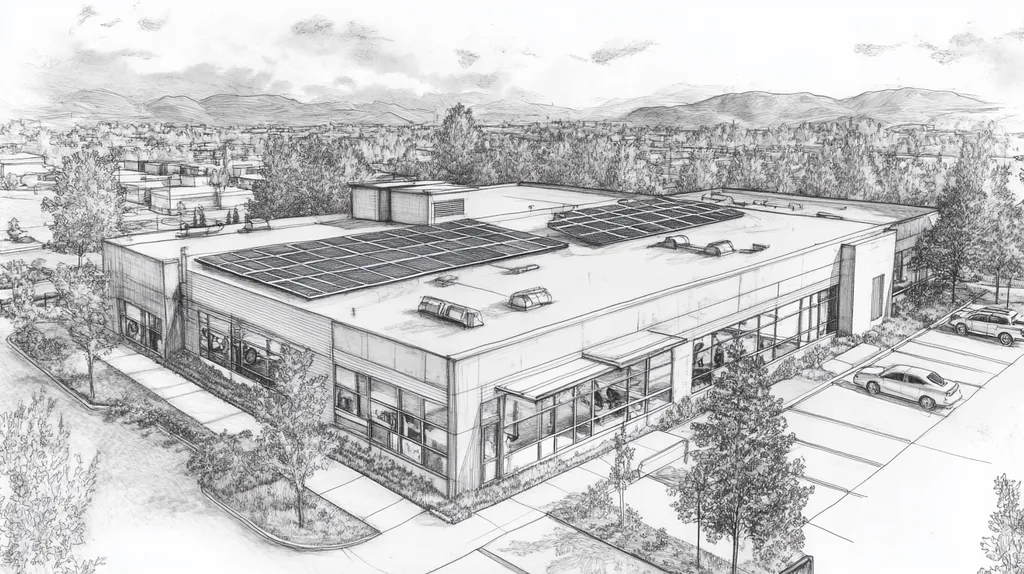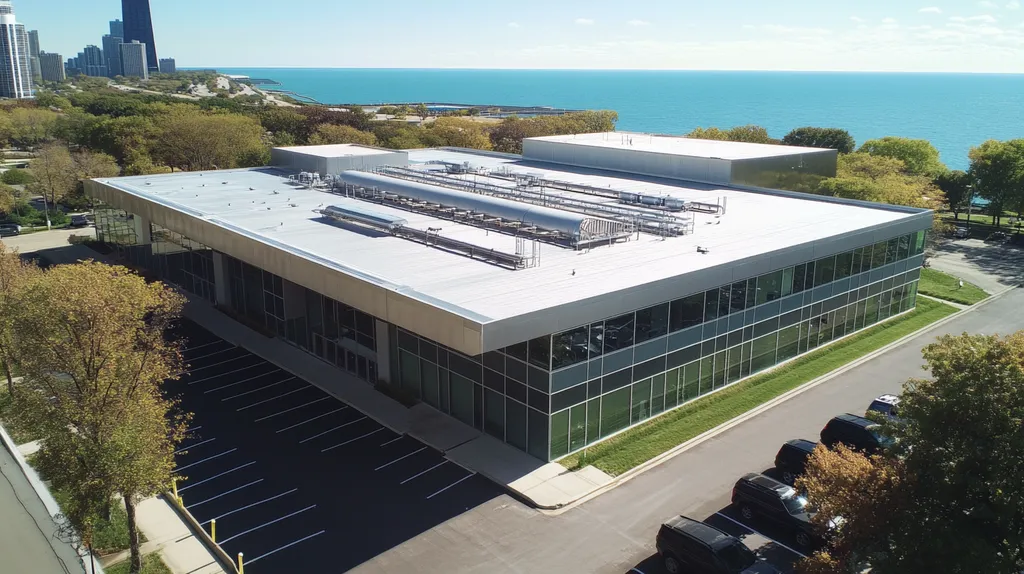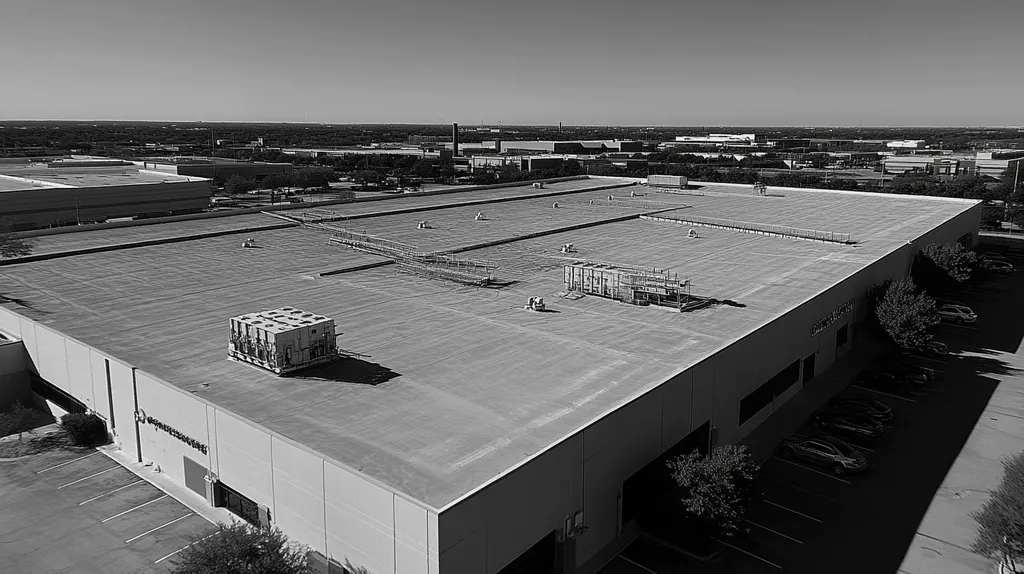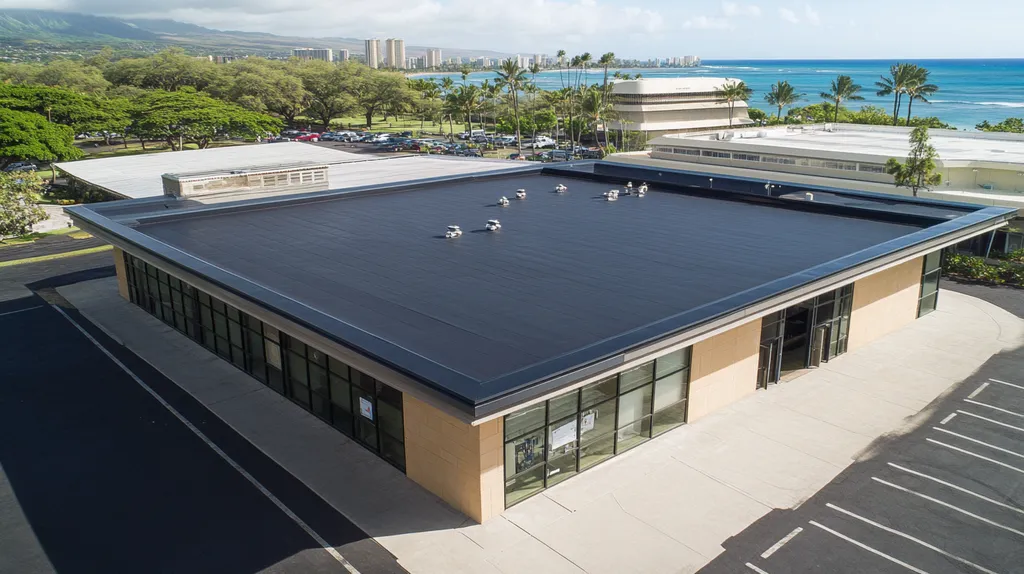Welcome to today’s Battle Royale featuring two roofing heavyweights: “TPO” in the east corner versus “PVC” in the west!
Tonight’s showdown pits these contenders against each other across six punishing rounds designed to test every aspect of their performance for Industrial Roofing Risks.
At stake? Millions in potential costs, decades of building protection, and the critical performance demands of modern commercial and industrial facilities.
Our professional judging panel will evaluate each round on technical merit, real-world performance, and value delivery. After all six rounds, we’ll declare our ultimate champion.
Ladies and gentlemen, facility managers and building owners… it’s time to rumble!
ROUND 1: INITIAL COSTS & INSTALLATION
The stakes in industrial roofing decisions extend far beyond initial expenses. Poor material selection or installation can lead to devastating consequences, including structural failures, operational shutdowns, and extensive damage to inventory and equipment. Making the right choice between TPO and PVC roofing systems requires careful consideration of both immediate costs and installation requirements.
Material Expenses
Poor roofing choices can lead to catastrophic failures, unexpected disruptions, and costly repairs that far exceed initial savings. These risks make material selection a critical decision point for any commercial property. (source: Union Galvasteel)
TPO membranes typically cost 15-30% less than comparable PVC options, making them an attractive choice for budget-conscious projects. However, the quality of TPO can vary significantly between manufacturers, potentially affecting long-term performance.
PVC membranes command a premium price point but deliver consistent quality across manufacturers. Their superior chemical resistance and proven longevity often justify the higher upfront investment.
For pure initial cost considerations, TPO holds the ADVANTAGE.
Installation Complexity
Installation complexity directly impacts project success rates and long-term performance. Proper installation ensures the roofing system delivers its intended protection and longevity.
TPO installations generally require less specialized training and fewer specific tools. The material’s flexibility and lighter weight make it easier to maneuver and position during installation.
PVC installations demand more precise techniques, particularly around seams and flashings. The material’s rigidity can make it more challenging to work with, especially in complex roof geometries.
Given the lower technical barriers and faster learning curve, TPO claims the ADVANTAGE in installation complexity.
Project Timeline
Project duration affects both direct costs and business interruption expenses. Longer installations increase exposure to weather risks and extend operational disruptions.
TPO projects typically progress 20-30% faster than comparable PVC installations. The material’s easier handling and simpler welding requirements allow crews to cover more area per day.
PVC installations require more time for proper setup and precise execution. While this thoroughness contributes to quality, it extends project timelines and increases labor costs.
With significantly faster completion times, TPO takes the ADVANTAGE.
ROUND 1 WINNER: TPO
ROUND 2: DURABILITY & LIFESPAN
In industrial roofing, durability and lifespan directly impact business continuity and profitability. A single roof failure can halt operations, damage inventory, and compromise worker safety, with potential losses reaching hundreds of thousands of dollars. Understanding how TPO and PVC materials perform over time is crucial for making informed decisions that protect both facilities and bottom lines.
Weather Resistance
Industrial roofs must withstand extreme temperatures, UV exposure, heavy precipitation, and severe weather events. Poor weather resistance can lead to premature degradation and costly emergency repairs.
TPO membranes offer good UV resistance and maintain flexibility across temperature extremes. However, their performance can vary significantly between manufacturers, particularly in regions with intense sun exposure.
PVC membranes demonstrate exceptional weather resistance, maintaining their protective properties even after decades of exposure. Their chemical composition provides superior resistance to UV degradation and temperature cycling.
With consistently superior performance across all weather conditions, PVC claims the ADVANTAGE.
Chemical Resistance
Industrial environments often expose roofing materials to harsh chemicals, oils, and industrial exhaust. These exposures can accelerate membrane deterioration if the material lacks proper chemical resistance.
TPO offers moderate chemical resistance but may show signs of degradation when exposed to certain industrial pollutants or chemical deposits. Regular cleaning and maintenance are essential to preserve its protective properties.
PVC demonstrates exceptional resistance to chemicals, oils, and industrial contaminants. Its molecular structure remains stable even under prolonged exposure to harsh industrial environments.
Given its superior chemical resilience, PVC takes the ADVANTAGE.
Service Life
Expected service life directly impacts long-term facility costs and maintenance planning. Poor roofing choices can lead to premature failures, forcing unplanned replacements and operational disruptions. (source: Union Galvasteel)
TPO roofing systems typically last 15-20 years when properly installed and maintained. However, their longevity can vary based on environmental conditions and manufacturer quality.
PVC roofing consistently delivers 20-30 years of service life, with many installations exceeding these estimates. Their proven track record of longevity makes them a reliable choice for long-term facility planning.
With significantly longer proven service life, PVC earns the ADVANTAGE.
ROUND 2 WINNER: PVC
ROUND 3: PERFORMANCE FACTORS
Performance factors in industrial roofing directly impact facility protection, operational continuity, and long-term cost management. When roofing systems fail to perform as needed, businesses face disrupted operations, damaged inventory, and compromised worker safety. Understanding how TPO and PVC roofing materials perform across key metrics helps facility managers make decisions that protect both their buildings and their bottom lines.
Durability Under Stress
Industrial roofs face constant challenges from foot traffic, equipment installations, and environmental stresses. Understanding how materials perform under these conditions is crucial for maintaining facility protection.
TPO membranes demonstrate excellent resistance to tears, punctures, and impact damage. Their flexible nature allows them to absorb shock and maintain integrity even in high-traffic areas or during maintenance activities.
PVC systems offer good puncture resistance but can become more brittle over time. While they maintain their protective properties, they may require more careful handling during maintenance and repairs.
With superior flexibility and impact resistance, TPO claims the ADVANTAGE.
Temperature Tolerance
Extreme temperature fluctuations put significant stress on roofing materials, affecting their performance and longevity. Material selection must account for local climate conditions and seasonal temperature ranges.
TPO maintains its flexibility and performance across a wide temperature spectrum. Modern formulations resist heat aging and cold-weather cracking, providing consistent protection year-round.
PVC performs well in moderate temperatures but can become rigid in extreme cold. This characteristic may lead to increased vulnerability during winter months in colder regions.
Given its superior performance across temperature extremes, TPO takes the ADVANTAGE.
Lifecycle Maintenance
Regular maintenance requirements significantly impact the total cost of ownership for roofing systems. Efficient maintenance protocols help prevent unexpected failures and extend service life.
TPO roofing systems typically require minimal maintenance beyond regular inspections. Their resistant surface and durable seams reduce the need for frequent repairs or extensive cleaning protocols.
PVC systems demand more rigorous maintenance schedules, particularly around seams and flashings. Their chemical resistance is excellent, but they need more frequent inspections to maintain optimal performance.
With lower maintenance demands and simpler upkeep requirements, TPO earns the ADVANTAGE.
ROUND 3 WINNER: TPO
ROUND 4: MAINTENANCE REQUIREMENTS
Maintenance requirements can make or break an industrial roofing system’s long-term performance and cost-effectiveness. Poor maintenance practices lead to premature failures, with studies showing that neglected roofs typically last only half their expected lifespan. For facility managers, understanding the distinct maintenance needs of TPO and PVC systems is crucial for protecting their investment and preventing catastrophic failures.
Regular Inspection Requirements
Industrial roofs demand systematic inspection protocols to identify and address potential issues before they escalate into major problems. The frequency and complexity of these inspections directly impact facility maintenance budgets and staff resources.
TPO roofing systems require quarterly inspections, with particular attention to seam integrity and surface degradation. The material’s relative sensitivity to UV exposure and chemical contamination necessitates more frequent monitoring of potential weak points.
PVC systems typically need only bi-annual comprehensive inspections due to their superior chemical and UV resistance. Their proven track record of stability allows for less frequent but equally thorough examination protocols.
With lower inspection frequency requirements, PVC claims the ADVANTAGE.
Repair Complexity
The ease and effectiveness of repairs significantly influence both maintenance costs and the potential for secondary damage from delayed fixes. Quick resolution of minor issues prevents them from developing into major problems.
TPO membranes can be repaired relatively easily with standard heat-welding equipment. Their flexibility and weldability make most repairs straightforward, allowing maintenance teams to address issues promptly.
PVC repairs require more precise techniques and specialized materials to maintain system integrity. However, the material’s durability means repairs are generally needed less frequently than with TPO systems.
Given its simpler repair procedures, TPO takes the ADVANTAGE.
Long-term Maintenance Costs
The total cost of maintaining a roofing system over its lifetime can significantly exceed initial installation expenses. Understanding these ongoing commitments is crucial for accurate budget planning.
TPO systems require more frequent maintenance interventions and repairs, particularly as they age. While individual repairs may be simpler, their higher frequency increases overall maintenance costs over time.
PVC roofing demonstrates superior resistance to aging and environmental factors, resulting in fewer maintenance requirements throughout its lifespan. This reduced maintenance frequency translates to lower long-term costs despite more complex repair procedures.
With lower lifetime maintenance expenses, PVC earns the ADVANTAGE.
ROUND 4 WINNER: PVC
ROUND 5: SUSTAINABILITY CREDENTIALS
Environmental considerations have become critical factors in industrial roofing decisions, with potential impacts extending far beyond basic compliance. Poor material choices can result in excessive energy consumption, increased carbon footprints, and toxic emissions that affect both worker health and the environment. Understanding the sustainability profiles of TPO and PVC helps facility managers make choices that protect both their operations and the planet.
Energy Efficiency
Energy efficiency directly impacts both environmental footprint and operational costs. Poor thermal performance can increase cooling loads by up to 40%, significantly affecting facility energy consumption.
TPO membranes feature highly reflective surfaces that maintain their solar reflectance index (SRI) over time. Their consistency in reflecting solar radiation helps reduce cooling costs and urban heat island effects.
PVC roofing systems also offer good initial reflectivity but may experience more significant degradation over time. While they can be manufactured in energy-efficient white formulations, their reflective properties often require more frequent maintenance to maintain effectiveness.
With superior long-term reflective performance, TPO claims the ADVANTAGE.
Recyclability and Material Lifecycle
The ability to recycle roofing materials significantly impacts their environmental footprint. Proper material selection can help divert thousands of tons of waste from landfills annually.
TPO membranes are fully recyclable and often contain recycled content in their manufacture. The material can be effectively reprocessed at the end of its service life, supporting circular economy initiatives.
PVC roofing presents more challenging recycling scenarios due to its chemical composition. While technically recyclable, the process requires specialized facilities and may produce harmful byproducts.
Given its superior recyclability and simpler processing requirements, TPO takes the ADVANTAGE.
Installation Safety and Air Quality
Installation safety and air quality impact both worker health and environmental compliance. The primary hazards involve exposure to hazardous substances and materials during installation and maintenance. (source: Nations Roof)
TPO installations produce minimal volatile organic compounds (VOCs) and require no special ventilation protocols. The material’s simpler chemical composition reduces exposure risks during installation and repairs.
PVC installations can release more significant levels of VOCs and may require additional safety measures. The material’s chemical composition necessitates careful handling and proper ventilation during heat welding.
With lower emissions and safer handling characteristics, TPO earns the ADVANTAGE.
ROUND 5 WINNER: TPO
ROUND 6: SPECIALIZED APPLICATIONS
When it comes to specialized industrial applications, choosing the wrong roofing system can lead to catastrophic failures and costly operational disruptions. In environments with extreme conditions like chemical processing plants, food manufacturing facilities, or high-temperature industrial operations, the stakes are particularly high. Understanding how TPO and PVC perform under specialized conditions is crucial for protecting both assets and operations.
Chemical Exposure Resistance
Industrial facilities often expose roofing systems to harsh chemicals, oils, and corrosive substances that can rapidly degrade traditional materials. The ability to withstand these exposures directly impacts system longevity and facility protection.
TPO membranes offer moderate resistance to common industrial chemicals but may show accelerated degradation when exposed to certain solvents and petrochemicals. Their performance can vary significantly between manufacturers and formulations.
PVC roofing demonstrates exceptional resistance to most industrial chemicals, including acids, bases, and organic compounds. Its molecular structure remains stable even under prolonged exposure to harsh industrial environments.
Given its superior chemical resistance properties, PVC claims the ADVANTAGE.
High-Temperature Applications
Many industrial processes generate significant heat that can affect roofing system performance. Proper material selection is crucial for facilities with exhaust vents, steam releases, or high-temperature equipment on the roof.
TPO membranes maintain flexibility and performance under moderate heat exposure but may show signs of premature aging when subjected to sustained high temperatures. Contemporary formulations have improved heat resistance but still have limitations.
PVC systems excel in high-temperature environments, maintaining their structural integrity and protective properties even when exposed to sustained heat. Their superior heat stability makes them ideal for facilities with demanding thermal conditions.
With better performance under high-temperature conditions, PVC takes the ADVANTAGE.
Specialized Equipment Integration
Industrial roofs often need to accommodate heavy equipment, penetrations for ventilation systems, and specialized mounting requirements. The roofing system must maintain its integrity while supporting these additional demands.
TPO membranes offer good flexibility for integrating roof-mounted equipment and can be easily modified to accommodate new installations. Their weldability makes it simpler to add flashings and adapt to changing facility needs.
PVC systems provide reliable support for equipment integration but require more precise installation techniques around penetrations and mountings. While highly effective when properly installed, they offer less flexibility for future modifications.
With greater adaptability for equipment integration, TPO earns the ADVANTAGE.
ROUND 6 WINNER: TIE
AND THE WINNER IS…
Ladies and gentlemen, after six grueling rounds of technical combat, we have a split decision! With TPO claiming three rounds, PVC taking two, and one round ending in a draw, this battle ends in a strategic DRAW!
TPO dominated the early rounds with superior cost-effectiveness, easier installation, and impressive sustainability credentials. Its flexibility and simpler maintenance requirements make it the undisputed champion for budget-conscious projects where initial costs and quick installation are paramount.
PVC proved its worth as a technical powerhouse, delivering knockout performances in durability and specialized applications. Its exceptional chemical resistance and proven longevity make it the clear choice for facilities facing harsh industrial conditions or requiring maximum service life.
But wait! Before you rush to corner either contender, remember that every building brings its own unique challenges to the ring. Local climate conditions, specific facility requirements, and regional installation expertise can all impact performance outcomes. While this analysis provides a championship-level overview, your facility’s specific needs may favor one contender over the other.
Professional consultation is essential – work with qualified roofing experts who can evaluate your specific situation and help you select the right champion for your corner.
Remember, in the high-stakes arena of industrial roofing, the true victory comes not from choosing the crowd favorite, but from matching your facility’s specific requirements with the right contender’s strengths. Now, let’s get ready for the next round of facility protection!
FREQUENTLY ASKED QUESTIONS
Q. What are the initial costs of a commercial roof installation?
A. Initial costs vary significantly between TPO and PVC materials. TPO is typically 15-30% cheaper but may have quality variations. PVC, while more expensive, consistently delivers superior quality, which might justify the investment in the long run.
Q. How long can an industrial roof last?
A. The lifespan of roofing materials can vary widely. TPO roofing typically lasts 15-20 years, while PVC roofing systems often exceed 20-30 years if properly installed and maintained, making them a more reliable long-term option.
Q. What factors should I consider for a commercial roof’s performance?
A. Performance factors include durability under stress, temperature tolerance, and maintenance requirements. Selecting a roofing system that excels in these areas is crucial for ensuring long-term protection and minimizing operational disruptions.
Q. How important is maintenance for an industrial roof?
A. Regular maintenance is vital for prolonging a roof’s lifespan. TPO systems typically require more frequent inspections and repairs, while PVC systems, although needing less frequent checks, demand careful monitoring around seams and flashings.
Q. How does energy efficiency impact commercial roofing choices?
A. Energy-efficient roofing can significantly lower cooling costs and the facility’s carbon footprint. TPO is known for maintaining high solar reflectivity over time, while PVC may require more maintenance to retain its reflective properties to stay energy efficient.
Q. What role does chemical resistance play in roof selection?
A. Chemical resistance is essential in industrial settings, as exposure to harsh substances can degrade roofing materials. PVC roofs generally provide superior resistance to a wide range of chemicals compared to TPO, making them a better choice in chemically intensive environments.
Q. How do specialized applications affect roofing material choice?
A. Specialized applications require careful selection of roofing materials to withstand specific conditions. Environments with extreme temperatures or chemical exposures often favor PVC for its durability and stability, while TPO offers flexibility for adapting to various installation needs.


